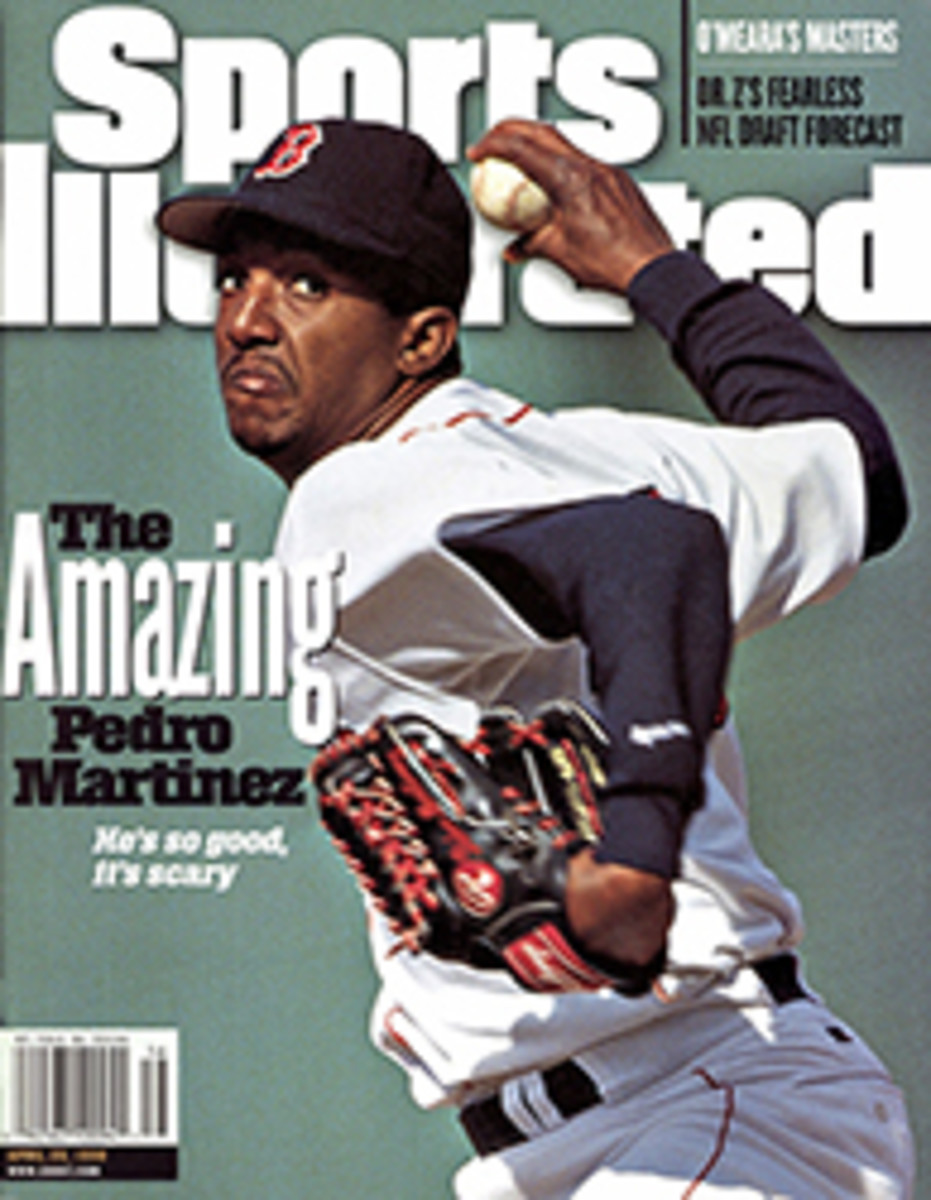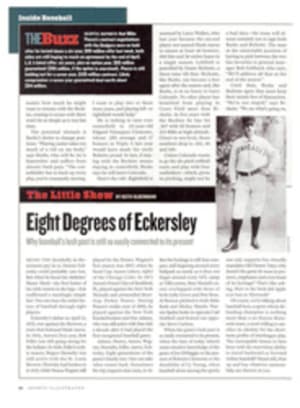
The Sky's The Limit Five years after walking on at Florida State, Andre Wadsworth has become the most coveted defensive player in the NFL draft
The handwriting on the letter that arrived at his mother's home
in Miami last Christmas Eve looked familiar, as well it should
have. Five years earlier, as a high school senior taking
advanced placement English at Florida Christian in Miami, Andre
Wadsworth had been required to write a letter to himself,
addressing his goals. Now the man he had become was about to get
reacquainted with the boy he once was. His letter, which his
English teacher had held on to and then mailed as promised, ran
three pages, and one of his predictions was that he would be
studying for an MBA in finance by now. (In fact, he is three
classes short of a master's in sports administration.) The
letter included just one sentence about football. The school's
final game of the '92 season was a few days away, and Wadsworth,
a defensive end who had received only one recruiting letter,
believed his athletic career was over. "This is the last time I
ever suit up for sports," he wrote.
How could anyone have known that Wadsworth, then 6'2" and 217
pounds, would grow two inches and gain 65 pounds over the next
four years. Who could have foreseen that he would begin his
college career as that lowest form of varsity life, a walk-on,
and leave Florida State as the most coveted defensive lineman in
the April 18-19 NFL draft? Barring a trade, the Arizona
Cardinals are expected to take the Seminoles' All-America with
the No. 3 pick. Wadsworth's talent is so well established now
that the roughly 100 NFL coaches and scouts on hand for a March
17 workout at Florida State merely shrugged when he pulled his
left quadriceps running the 40. "I think we all know what kind
of football player he is," Kansas City Chiefs coach Marty
Schottenheimer said.
In an NFL that continually creates new levels of specialization,
Wadsworth is coveted for his versatility. As a 6'4" junior he
played at 282 pounds and started at noseguard between
All-America ends Peter Boulware and Reinard Wilson. As a senior
Wadsworth dropped 15 pounds, shifted to left end, and combined
speed and power to finish the season with only three fewer sacks
than the school-record 19 Boulware had in '96. Phil Savage, the
director of college scouting for the Baltimore Ravens, says
Wadsworth could thrive in a 3-4 defense or a 4-3, left side or
right. "He's quick and fast enough to play on the right as a
rush guy, but he's strong enough to play on the left," Savage
says. "He's probably, most people would say, the best defensive
player in the draft," says Atlanta defensive coordinator Rich
Brooks. The Steelers' college personnel director, Tom Modrak,
ticked off the reasons why: "He's like a missile when he comes
off the ball. He can keep his pads low and still run full speed.
He's flexible, and he's around 280 pounds."
We've all heard the stories of unrecruited athletes who were
fueled by the snubs of coaches and competitors. This is not one
of those stories. Wadsworth had no interest in the only school
that recruited him, the State University of New York at Stony
Brook, and he isn't angry that other schools didn't pursue him.
He jumped at the opportunity to walk on at Florida State, but he
never imagined he would become an All-America. As a redshirt
freshman, Wadsworth was asked to fill out a sheet of goals for
strength coach Dave Van Halanger. Wadsworth wrote that he hoped
to bench-press 385 pounds by his final season. (He benches 500.)
He wanted to squat 450 pounds. (He squats nearly 700.) "And I
wanted to start my senior year at defensive end," Wadsworth says
laughing. "That was the only one [that was on the mark]."
While Wadsworth developed into a collegiate superstar, he never
developed the superstar's ego. Leave it to the Charles Woodsons
of the world to demand first-class airline tickets before
agreeing to attend an awards banquet. "As soon as you get to [an
NFL] training camp, all that ranked-high stuff goes out the
window," Wadsworth says. "You've got to show it. They say I'm
the best defensive end in several years. Next year there will be
another guy who they say is the best."
Last year that player was Boulware, who gave up his final year
of college eligibility, was drafted by Baltimore with the No. 4
pick, shifted to linebacker and became the NFL defensive rookie
of the year. He and Wadsworth are as close as brothers. "I can
say, for me and Andre, that if you look at us from the beginning
of our time at Florida State to now, you can tell we were
blessed," Boulware says.
In January, Boulware returned to Tallahassee and reclaimed his
room in the house that he and Wadsworth have shared for two
years. They work out together at Florida State, and both speak
regularly to church groups. At least half of the Seminoles
coaches are devout Christians, including Bobby Bowden, defensive
ends coach Jim Gladden and Van Halanger. When they talk about
how good Wadsworth is, they don't always mean on the football
field. In fact, they sound like a bunch of yentas trying to
arrange a marriage. In February, Bowden and Van Halanger,
without prompting, expressed their belief that Wadsworth is a
virgin. "I don't think Andre has been with a woman," Bowden said.
Wadsworth says he is not a virgin, but in five years at Florida
State he says he never had a date. Of his time in high school,
he says, "I was into the world of premarital sex. You grow up.
You mature. Then you do things because you know it's right. You
don't care that people say you're square. If you're going to be
a good example, how far are you willing to go? Is kissing a sin?
Is fondling a sin? Or do you stay away from [girls] and go out
and have a good time?"
Wadsworth and Boulware wear matching cloth bracelets bearing the
letters WWJD--What would Jesus do? If the answer to that
question isn't enough to stop temptation, they rely on each
other. "Don't get caught in a buzz saw," Boulware says. "College
is college. There are a lot of fine girls around here."
"In the pros, it's harder [to resist temptation]," Wadsworth
speculates. "The girls are finer."
"And you have money," Boulware notes.
Wadsworth could well have pocketed some of the NFL's riches
after his junior season. Although a neck injury forced him to
miss two games that year, he played so well in two season-ending
games against Florida (the regular-season finale and the Orange
Bowl) that the NFL advisory committee told him he might be
drafted in the second round. The allure of following Boulware to
the NFL immediately, however, didn't match the allure of
following him at Florida State. Knowing he would be moved to
Boulware's slot at left end, Wadsworth wanted the spotlight that
shines on a sack-happy defensive end.
After Wadsworth performed mechanically in the first 1997 fall
scrimmage, though, Bowden had doubts about the switch. Are we
making a mistake with [number] 85? he wrote in his notes.
Gladden saw the comment and relayed the message to the player.
In the next scrimmage Wadsworth had five sacks.
That was reminiscent of his first play in practice as a redshirt
scout-team defensive end in '93, when he knocked starting tackle
Marvin Ferrell on his rear. That season Ferrell played on a line
that helped quarterback Charlie Ward win the Heisman Trophy and
the Seminoles win the national championship. At most practices
that starting line faced a defensive front of redshirts that
featured Wadsworth and Boulware, as well as Julian Pittman and
Greg Spires, both of whom are expected to be drafted. "We were a
bad scout team," Boulware says. "In practice the scout team
isn't supposed to go too hard, but Andre came in and tried to
kill everybody."
"I was a walk-on," Wadsworth says in self-defense. "You don't
want to go out there half-speed."
In the spring of '94, with a shortage of bodies inside, the
Seminoles moved Wadsworth to noseguard. "Andre didn't know how
to get into a three-point stance," says assistant coach Chuck
Amato. "He put his knuckles instead of his fingertips on the
ground." But he learned soon enough. In his first game, against
Virginia in the '94 opener, Wadsworth sacked quarterback Symmion
Willis, causing a fumble that set up a Florida State touchdown.
By the sixth game that season, against Clemson, Wadsworth made
the first of his 42 career starts.
As a sophomore he finished second on the Seminoles in tackles
and made second-team All-ACC. His best season came as a senior
when he had three sacks in each of Florida State's biggest
conference games, against Clemson, Virginia and North Carolina.
Florida tackle Mo Collins limited Wadsworth to just two tackles
in the Gators' 32-29 victory that denied Florida State a chance
to play for the national championship. But in his final start as
a Seminole, in the Sugar Bowl, Wadsworth had two sacks and the
first interception of his career in the 31-14 defeat of Ohio
State. Wadsworth benefited from some special "coaching" in that
game. Boulware and Wilson were watching from the Florida State
sideline, and between defensive series, Wadsworth says, "I went
over to Pete and Reinard and said, 'What do I need to do now?'
Pete says, 'You need to speed-rush. You haven't speed-rushed
them yet.' So I speed-rushed and got a sack."
With the next phase of his life about to begin, what would
Wadsworth write in another letter to himself that he would not
read for five years? "I'd put in ridiculous stuff," he says.
"'Well, this is my fifth year in the Pro Bowl. Everyone's
forgotten all about Bruce Smith and Reggie White.'" Wadsworth
laughs. Of course, for a walk-on who became an All-America and
an almost certain top-five NFL pick, ridiculous things have
happened before.
COLOR PHOTO: ANN STATES/SABA [Andre Wadsworth]
COLOR PHOTO: JOHN BIEVER CRUNCH Wadsworth's strengths are power and speed, as Florida's Danny Wuerffel learned in '96. [Danny Wuerffel being tackled by Andre Wadsworth]
"He's like a missile when he comes off the ball. He can keep his
pads low and still run full speed."

